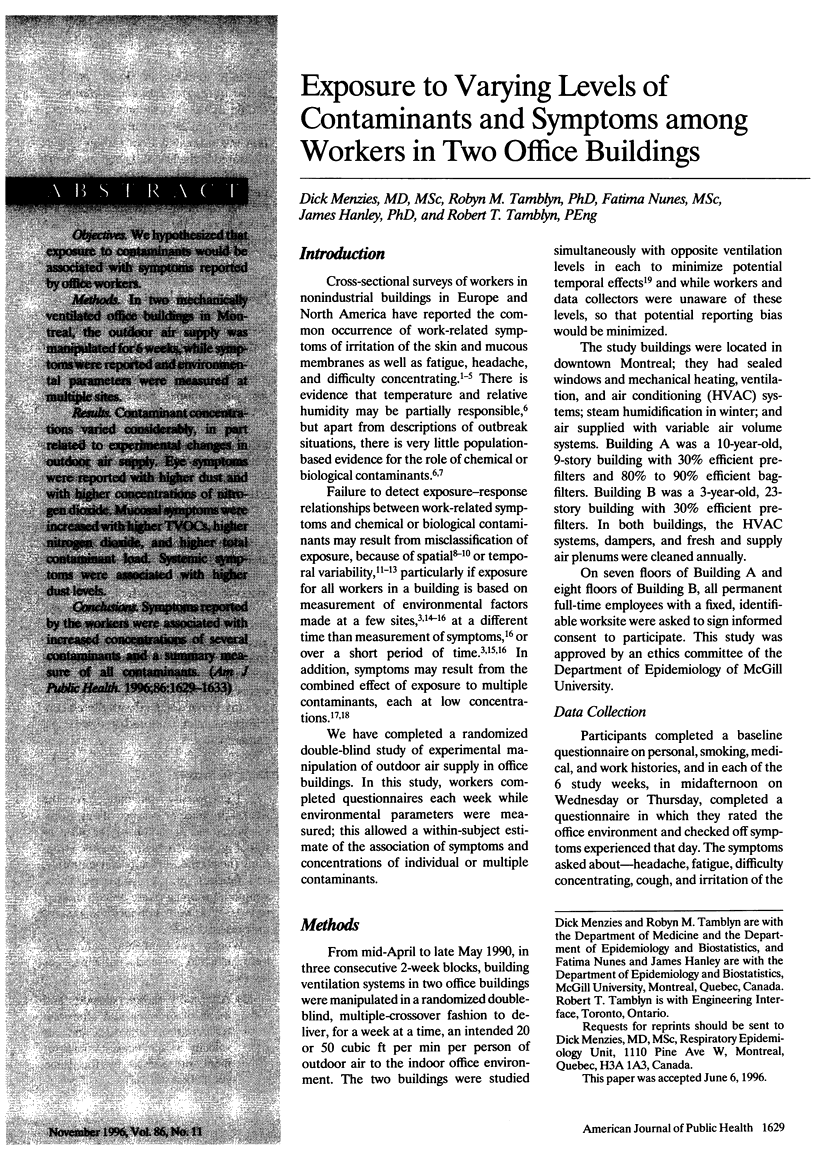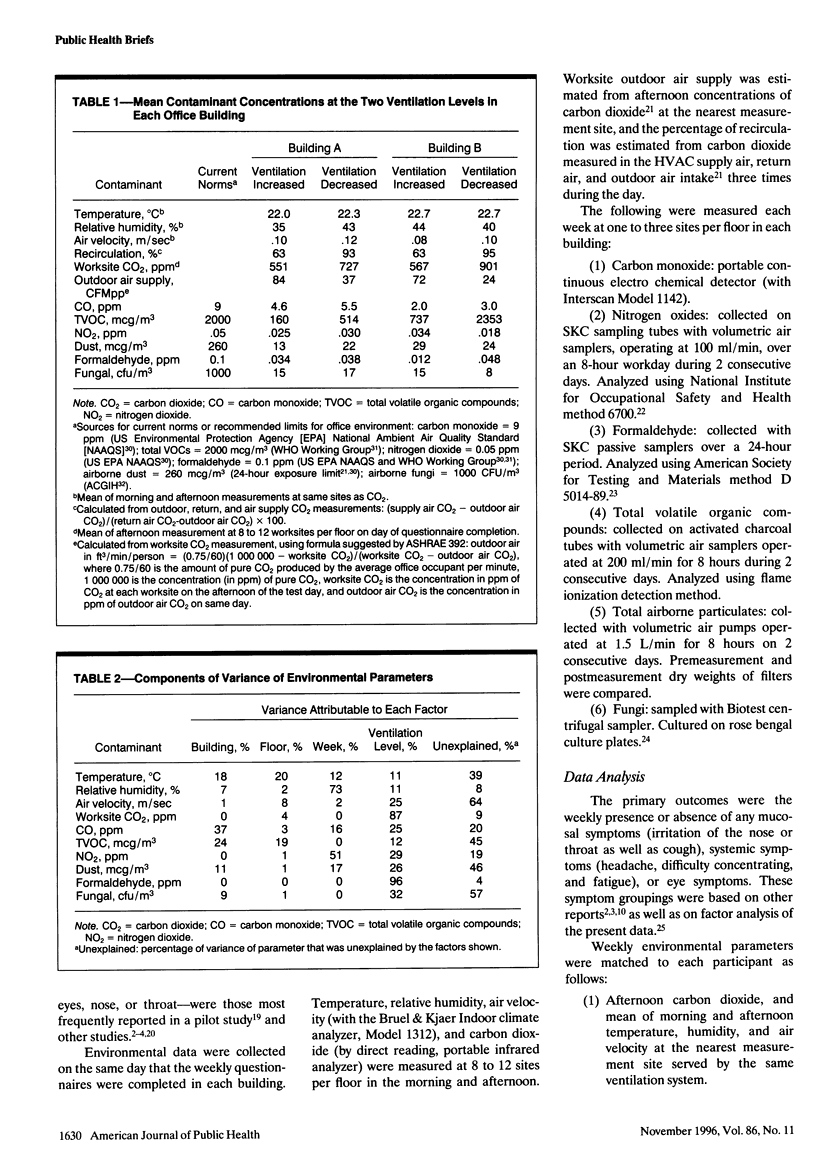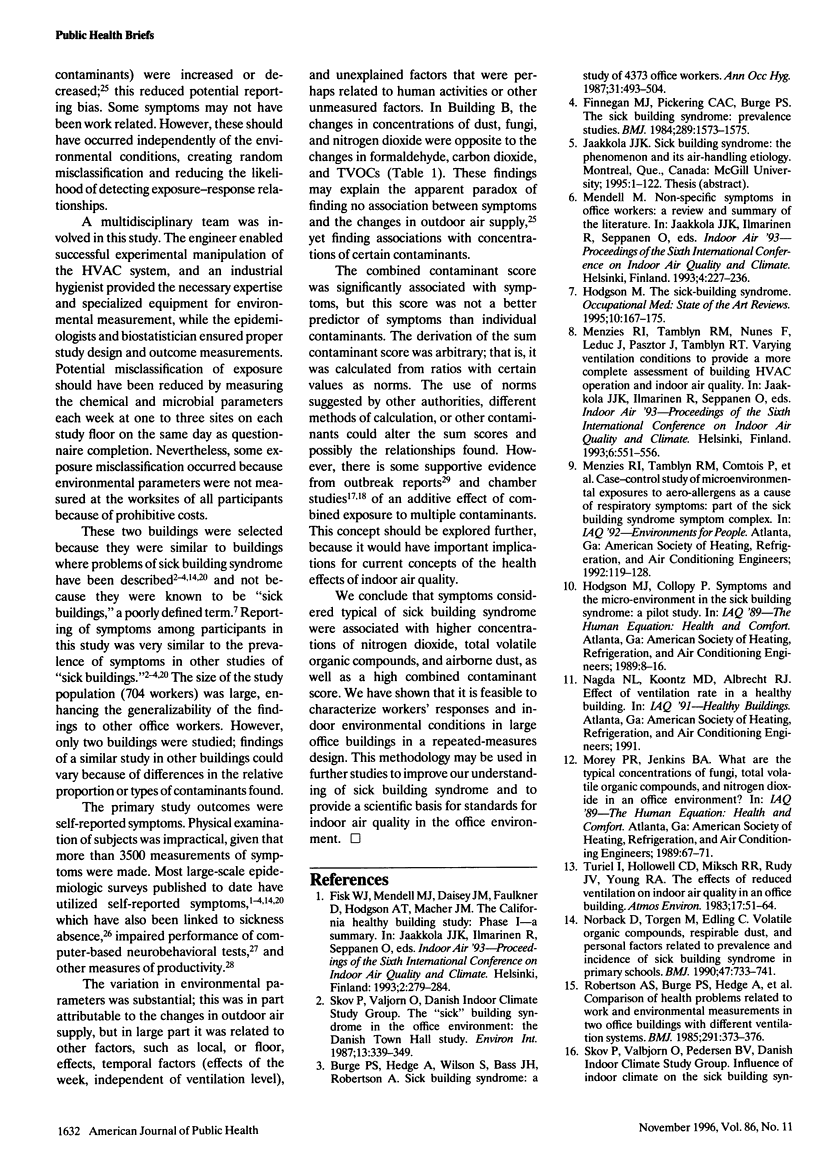Abstract
OBJECTIVES: We hypothesized that exposure to contaminants would be associated with symptoms reported by office workers. METHODS: In two mechanically ventilated office buildings in. Montreal, the outdoor air supply was manipulated for 6 weeks, while symptoms were reported and environmental parameters were measured at multiple sites. RESULTS: Contaminant concentrations varied considerably, in part related to experimental changes in outdoor air supply. Eye symptoms were reported with higher dust and with higher concentrations of nitrogen dioxide. Mucosal symptoms were increased with higher TVOCs, higher nitrogen dioxide, and higher total contaminant load. Systemic symptoms were associated with higher dust levels. CONCLUSIONS: Symptoms reported by the workers were associated with increased concentrations of several contaminants and a summary measure of all contaminants.
Full text
PDF




Selected References
These references are in PubMed. This may not be the complete list of references from this article.
- Burge S., Hedge A., Wilson S., Bass J. H., Robertson A. Sick building syndrome: a study of 4373 office workers. Ann Occup Hyg. 1987;31(4A):493–504. doi: 10.1093/annhyg/31.4a.493. [DOI] [PubMed] [Google Scholar]
- Faust H. S., Brilliant L. B. Is the diagnosis of "mass hysteria" an excuse for incomplete investigation of low-level environmental contamination? J Occup Med. 1981 Jan;23(1):22–26. doi: 10.1097/00043764-198101000-00013. [DOI] [PubMed] [Google Scholar]
- Finnegan M. J., Pickering C. A., Burge P. S. The sick building syndrome: prevalence studies. Br Med J (Clin Res Ed) 1984 Dec 8;289(6458):1573–1575. doi: 10.1136/bmj.289.6458.1573. [DOI] [PMC free article] [PubMed] [Google Scholar]
- Mendell M. J., Smith A. H. Consistent pattern of elevated symptoms in air-conditioned office buildings: a reanalysis of epidemiologic studies. Am J Public Health. 1990 Oct;80(10):1193–1199. doi: 10.2105/ajph.80.10.1193. [DOI] [PMC free article] [PubMed] [Google Scholar]
- Menzies R., Tamblyn R., Farant J. P., Hanley J., Nunes F., Tamblyn R. The effect of varying levels of outdoor-air supply on the symptoms of sick building syndrome. N Engl J Med. 1993 Mar 25;328(12):821–827. doi: 10.1056/NEJM199303253281201. [DOI] [PubMed] [Google Scholar]
- Molfino N. A., Wright S. C., Katz I., Tarlo S., Silverman F., McClean P. A., Szalai J. P., Raizenne M., Slutsky A. S., Zamel N. Effect of low concentrations of ozone on inhaled allergen responses in asthmatic subjects. Lancet. 1991 Jul 27;338(8761):199–203. doi: 10.1016/0140-6736(91)90346-q. [DOI] [PubMed] [Google Scholar]
- Norbäck D., Torgén M., Edling C. Volatile organic compounds, respirable dust, and personal factors related to prevalence and incidence of sick building syndrome in primary schools. Br J Ind Med. 1990 Nov;47(11):733–741. doi: 10.1136/oem.47.11.733. [DOI] [PMC free article] [PubMed] [Google Scholar]
- Robertson A. S., Burge P. S., Hedge A., Sims J., Gill F. S., Finnegan M., Pickering C. A., Dalton G. Comparison of health problems related to work and environmental measurements in two office buildings with different ventilation systems. Br Med J (Clin Res Ed) 1985 Aug 10;291(6492):373–376. doi: 10.1136/bmj.291.6492.373. [DOI] [PMC free article] [PubMed] [Google Scholar]
- Tamblyn R. M., Menzies R. I., Tamblyn R. T., Farant J. P., Hanley J. The feasibility of using a double blind experimental cross-over design to study interventions for sick building syndrome. J Clin Epidemiol. 1992 Jun;45(6):603–612. doi: 10.1016/0895-4356(92)90132-7. [DOI] [PubMed] [Google Scholar]


